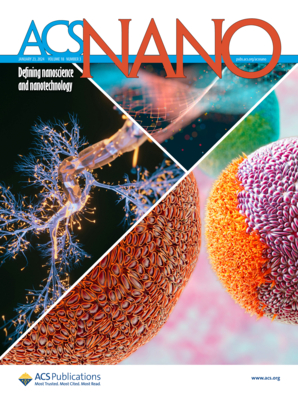A Green Cellulose Dissolution System for Producing Tunable Regenerated Nanocellulose Formate
IF 16
1区 材料科学
Q1 CHEMISTRY, MULTIDISCIPLINARY
引用次数: 0
Abstract
Different from the most used ionic liquids or cosolvents of the cellulose dissolution system, we reported a cellulose dissolution method by coupling LiBr·3H2O preimpregnation at room temperature (RT) with dissolution of cellulose in formic acid (FA) for controllable production of nanocellulose. This method yields a high solubility (up to 10 wt %) of cellulose, which consequently facilitates the preparation of tunable regenerated nanocellulose formate (RNCF) with versatile applications. The LiBr·3H2O preimpregnation at RT significantly improved the dissolution efficiency of cotton pulp by increasing cellulose accessibility via largely breaking hydrogen bonds and deconstructing the cellulose crystalline structure. This effect was attributed to the synergistic actions of hydrated Li+ coordination with the O of cellulose hydroxyls and the bond of Br– to H of cellulose hydroxyls, based on the verification of XPS, solid-/liquid-state NMR, and hydrogen–deuterium exchange characterization. The subsequent FA dissolution and regeneration process yielded RNCF with 100% yield, high degree of substitution (DS > 1.2), and tunable degree of polymerization (300–700) of the resultant RNCF. The dissolved CF in FA can serve as a functional building block to reassemble as strong RNCF filaments, films, hydrogels, or aerogels via a versatile regeneration route. The nanosized RNCF is further showcased to stabilize both oil-in-water and high internal phase water-in-oil Pickering emulsions. Therefore, this simple, ambient, sustainable, and cost-effective LiBr·3H2O preimpregnation approach could largely enhance cellulose accessibility, highly promoting cellulose dissolution and sustainable production of RNCF and boosting the utilization of cellulose-based functional materials.

绿色纤维素溶解体系生产可调再生纳米纤维素甲酸酯
不同于纤维素溶解体系中常用的离子液体或共溶剂,我们报道了一种室温(RT)下LiBr·3H2O预浸渍与甲酸(FA)中纤维素溶解耦合的纤维素溶解方法,以实现纳米纤维素的可控生产。这种方法产生高溶解度(高达10 wt %)的纤维素,从而有利于制备具有多种用途的可调再生纳米纤维素甲酸酯(RNCF)。室温下的LiBr·3H2O预浸渍通过破坏纤维素的氢键和解构纤维素的晶体结构,提高了纤维素的可及性,显著提高了棉浆的溶解效率。XPS、固体/液态核磁共振和氢氘交换表征证实,这种效应归因于水合Li+与纤维素羟基上的O和纤维素羟基上的Br -与H键的协同作用。随后的FA溶解和再生过程得到了100%收率的RNCF,取代度高(DS >;1.2),所得RNCF的聚合度可调(300-700)。溶解在FA中的CF可以作为功能构建块,通过多种再生途径重新组装成强RNCF细丝、膜、水凝胶或气凝胶。纳米RNCF在水包油和高内相油包水皮克林乳状液中的稳定性得到进一步证明。因此,这种简单、环保、可持续、经济的LiBr·3H2O预浸渍方法可以在很大程度上提高纤维素的可及性,极大地促进纤维素的溶解和RNCF的可持续生产,促进纤维素基功能材料的利用。
本文章由计算机程序翻译,如有差异,请以英文原文为准。
求助全文
约1分钟内获得全文
求助全文
来源期刊

ACS Nano
工程技术-材料科学:综合
CiteScore
26.00
自引率
4.10%
发文量
1627
审稿时长
1.7 months
期刊介绍:
ACS Nano, published monthly, serves as an international forum for comprehensive articles on nanoscience and nanotechnology research at the intersections of chemistry, biology, materials science, physics, and engineering. The journal fosters communication among scientists in these communities, facilitating collaboration, new research opportunities, and advancements through discoveries. ACS Nano covers synthesis, assembly, characterization, theory, and simulation of nanostructures, nanobiotechnology, nanofabrication, methods and tools for nanoscience and nanotechnology, and self- and directed-assembly. Alongside original research articles, it offers thorough reviews, perspectives on cutting-edge research, and discussions envisioning the future of nanoscience and nanotechnology.
 求助内容:
求助内容: 应助结果提醒方式:
应助结果提醒方式:


